Antique Italian Cantagalli Tin Glazed Blue & White Plate Decorated Putti. 19 th
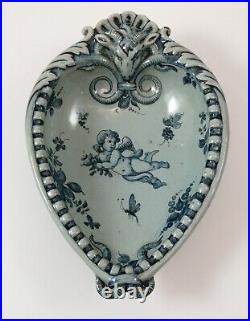
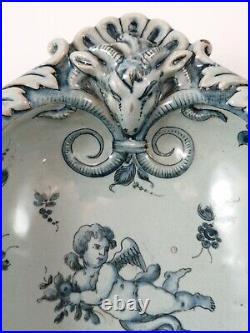
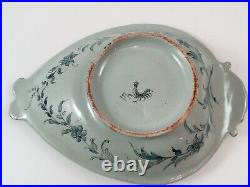


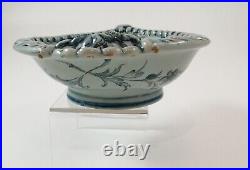


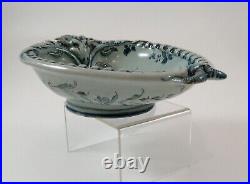


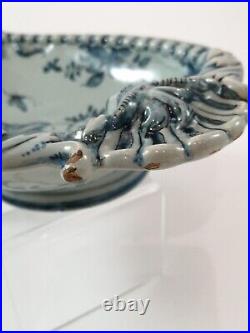
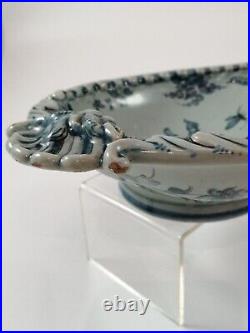



The plate has an unusual egg shape and is raised on one side with an elaborate ram's head at the top. The bottom of the plate depicts an angel surrounded by flowers. He was born into a family of Italian pottery makers, the Cantagalli name having been associated with ceramics since the 15th century. However, it's unclear whether they were makers or merchants. It's been established, though, that they were well known in Impruneta (a town south of Florence) as "furnacers", land and property owners, and that the Cantagalli factory was producing ceramics in Florence by the beginning of the 18th century.
His artisans thrived under Ulisse's guidance, nurturing his dream to establish a center of Decorative Arts to showcase Italian talents. At the same time, he scoured art galleries, museums and private collections in constant search of Renaissance majolicas to draw inspiration from. When he found a piece he liked, he sketched its design on a large acetate sheet, using pastel colors and tempera. His surviving sketchbook bears testimony to his draughtsmanship, great artistic ability, and eye for detail.In the article on Cantagalli's life and work, Sheila Forbes explains how, in the 1870s, the English influence was so compelling that Florence was styled'the Glorious English Florence', a term supported by major discriminating collectors like Frederick Stibbert, and H. Horne, collector and art critic, who both lived in Florence, as well as other men of taste, for example, Lord Carmichael, a passionate collector of Cantagalli, John Ruskin, William Morris, and William De Morgan with whom Ulisse developed a special working relationship.
Ulisse Cantagalli relished the popularity of his work both with local collectors and foreigners on the Grand Tour, providing the discerning collectors with high-quality reproductions of Robbiane, Renaissance majolicas, lusterware and pieces in the Islamic and Moresque styles. He decorated the house of Stibbert in Florence, now a museum, made the Della Robbia style "tondi" (circular sculptures) for Palazzo Pitti. Margaret Cantagalli worked with her husband, cultivating and maintaining good relationships with British buyers. By 1895 the Manifattura Cantagalli was famous throughout Europe, employed 121 workers and published a catalog featuring 1069 products. Ulisse never stopped looking for new designs in Italy and abroad. In 1892 he visited the Azulejos factory in Seville, and traveled on from there to Tangier. In 1901 he went looking for inspiration in Egypt, where he was taken ill and eventually died.The Manifattura Cantagalli continued to thrive under the guidance of Margaret Cantagalli, Ulisse's wife. After Margaret's death in 1930, her daughter Flavia took over. However, she was not successful in her attempt to break away from the company's commitment to the traditional, and the factory was finally closed in the 1950s. The Cantagalli mark was a "singing cockerel" - a visual translation of the family name.
The sketchy cockerel has an open beak, extended neck; one of its claws is raised, while the other usually rests on a single line. Ulisse's early production was also identified by a shield and family crest, but from 1880 the cockerel has been on its own.Length 23 cm Width 16 cm Height 6? Some minor enamel damage in some places. Otherwise in excellent antique condition. Please carefully regard all photos.
This item is in the category "Pottery, Ceramics & Glass\Decorative Cookware & Tableware\Plates". The seller is "popugai" and is located in this country: GB. This item can be shipped worldwide.
- Pattern: Putti
- Antique: Yes
- Occasion: All Occasions
- Material: Ceramic
- Colour: Blue and White
- Brand: Cantagalli
- Type: Decorative Plate
- Original/Licensed Reproduction: Original
- Era: Victorian (1837-1900)
- Theme: Angels
- Style: Renaissance
- Production Style: Art Pottery
- Time Period Manufactured: 1850-1899
- Country/Region of Manufacture: Italy
- Production Technique: Tin Glazed
- Backstamp: Painted
- Finish: Tin Glaze
- Handmade: Yes
- Product Line: Renaissance majolica
